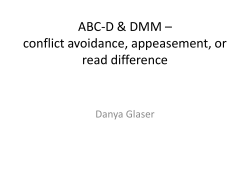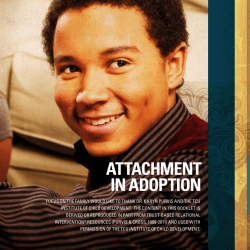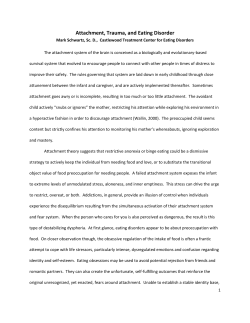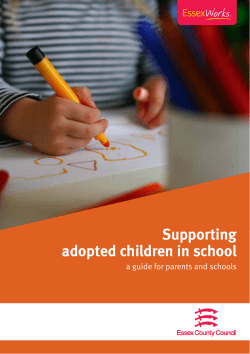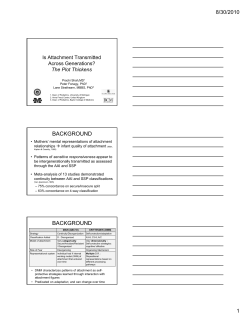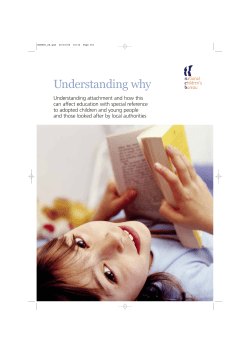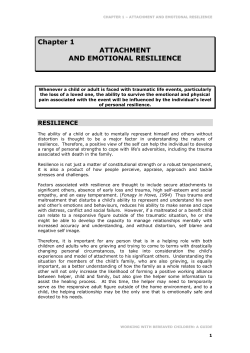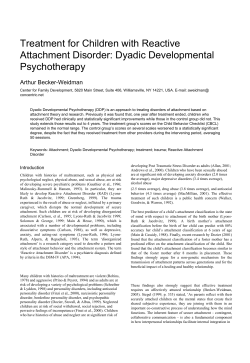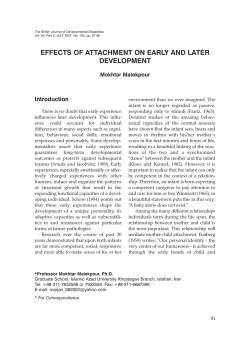
Early Intervention Services for Children who Have Experienced Trauma and
Report for Winston Churchill Memorial Trust Helen Runciman, MAHons, DipSW Early Intervention Services for Children who Have Experienced Trauma and who have disrupted Attachment Strategies. Fellowship to USA and Australia October – December 2010 Become the Change You Want to See in the World - Mahatma Ghandi, in the run up to Independence. I heard about the Winston Churchill Memorial Trust by complete happenstance, talking to a friend one day. Having gone immediately to look at the website, and seen that applications were being invited from people working in the field of early intervention and preventative services, exactly the area in which I have been working for the past two years, I filled in the application and sent it away. It seemed to be a very short road from that point, the end of September 2009, to the day in February the following year when I got the letter of confirmation of my fellowship, headed by the words, written in very large type, “with opportunity comes responsibility.” From the outset, the tone of all my contact with the Trust was about helping me to have an experience that would be the most fulfilling possible for me and for my wider professional community. I was not asked to account for myself and my itinerary in minute detail or to have to notify of every change of plan and new contact I discovered in the process – there was an assumed expectation of professionalism and integrity in the journey taken primarily in pursuit of new learning. The WCMT do emphasise however that it is also in essence a travel fellowship, the very nature of which is encapsulated by what (according to Alan de Botton in his most perfect accompaniment to such a journey „The Art of Travel‟, Ref 2) the Greek philosophers termed eudaimonia, or „human flourishing.‟ The nature of the Fellowship is such that it allows for the utmost creativity in the design of the idea and welcomes applications from those who have had a burning ambition that they want to realise, as well as those, like me, who took a much more organic approach to the application and had many ideas, which were distilled over a period of 6 months. This was the time it took to develop contacts and networks across the two continents I had elected to visit, to enable me to make a route map that would fill six weeks and at the same time fulfill my ambitions, be true to the spirit of the Fellowship and would see me come back to Scotland with new knowledge and learning that I would hope to put to good use in the context I work in. The Proposal My current job is that of manager of a multi disciplinary team including social work, health and education professionals that focuses on the delivery of Early Intervention Services to vulnerable families and children. I have worked as a social worker in various different guises for the past 17 years, almost exclusively with vulnerable children and families and have seen a sea change in the approach over that time to the way in which services are delivered. New information, research and practice based evidence has come to the fore that has changed what we might have thought before and exponentially increased what we know about children, notably in the field of child development. Policy and practice have not necessarily caught up with this though and the service that our most vulnerable families gets from the agencies they come into contact with is highly variable. The initial motivation behind my application was to have a look at different approaches to working with and supporting the most vulnerable populations of children and look at the ways in which these are translated into direct practice. My core belief is that it is a fundamental human right that each us should have the opportunity to develop our full potential. By and large, it is life events that get in the way, with sometimes devastating effects, to hamper children‟s ability to achieve this. The extensive research conducted by Wilkinson and Pickett (Ref 3) over thirty years proved conclusively that the societies that fare best are the most equal ones. Given that we in Britain live in one of the most unequal societies in the developed world, there is clearly scope for us to redress this and so on practical as well as humanitarian terms it makes sense for us to tackle this. My interest was not so much about finding solutions to the psychosocial conditions that so often accompany childhood trauma but at looking at ways of minimizing the impact of this and helping children on a path to recovery. I chose to go to two continents, the USA and Australia to do two things: one, to follow a thread of how both trauma and attachment theories are applied in both clinical and practice settings to help children and their families, biological and other, and the second was to look at models informed by attachment theory and with a relational focus, that were being used for working with and helping very vulnerable families strengthen their parenting capacity. The choice of continents was driven initially by my interest in the work of Dr Bruce Perry and the Child Trauma Academy (www.childtraumaacademy.org) based in Houston, Texas, and Dr Dan Hughes (www.danhughes.org) and there was a strong thread that could be followed with their work across both continents. There were other practical considerations that influenced my itinerary such as language, commonality of issues that services were facing on both continents and to some degree, the shared research and knowledge base between the USA, Australia and the UK. I spent three weeks on both continents and as well as visiting different facilities, clinical settings and organizations, built in time to read, do a bit of internet research and write a blog detailing my travels (which can still be accessed and has some lovely pictures helenrunciman.wordpress.com). My Itinerary Was as Follows: • Charlotte, North Carolina (Thomson Family Focus, Alexander Youth Network) • Helena, Montana (Intermountain) • Portland, Oregon ( Circle of Security Training) • Sydney (Barnardo‟s, Benevolent Society) • Melbourne (Take 2 Project) Rather than detail every aspect of the trip, I have chosen to focus on the experiences on the trip that had the greatest impact and from where I got the ideas and inspiration that I hope to incorporate into and share with a wider professional community. Thomson Family Focus, Alexander Youth Network - North Carolina I chose to visit these facilities because both work from relational, as opposed to behavioural models and used two of the approaches I had decided to focus on. Thomson Family Focus (TFF) is consulted to by Dan Hughes, whose model of Dyadic Developmental Psychotherapy has international recognition and is highly rated as an approach to working with children who have experienced trauma and who have attachment disorders. He comes to Scotland regularly to speak and train and his approach is incorporated by many of the therapeutic and fostering and adoption services for children in care across Scotland and the UK. The Alexander Youth Network (AYN) is one of a number of facilities across the US who have been involved in the Beta testing of the assessment model that has been developed by the Child Trauma Academy, namely the Neurosequential Model of Therapeutics (NSM) which I will talk about later on. Thomson Family Focus was founded in 1886 as an orphanage and has developed and evolved since to its current being, which is to offer education, treatment and care from three different sites to children and families with a wide range of needs primarily rooted in experience of childhood trauma. The first of the sites that I visited was the St Peter‟s Lane Campus, a Psychiatric Residential Treatment Facility (PRTF) set in acres of leafy grounds in a quiet suburb on the edge of Charlotte. This site has evolved over the years from orphanage to group home, looking after generally older children, many referred from juvenile justice services. Until the late eighties, they worked primarily from a behavioural model. Two things happened - it was recognised that there was a huge population of children across the state and beyond with severe emotional problems and a variety of attachment related problems that weren‟t being served by the model they had been using. The management team also realised that the behavioural approach just didn‟t work, and that children were being neither helped nor motivated in any positive way at all by someone following them around with a clipboard giving them a point for tying their shoe laces in the morning and taking one off if they didn‟t. The current clinical director started to look at other approaches and was drawn to Dan Hughes‟ model of Dyadic Developmental Psychotherapy and TFF been using this as their primary therapeutic modality for the past few years. I wasn‟t able to spend much time there – they were understandably busy and could only spare a couple of hours really just to show me round and have some brief discussion, but it was a first step on the Fellowship journey, a chance to start talking the language and thinking about some of the issues that would come up time and time again. The first one related to the whole question of mental health labelling. TFF offer a range of services across the three campuses to children from the age of 3 to 18, though this age range incorporates children who attend their child development centre and families who benefit from the intensive in home visiting service. The residential treatment facility is for older children, average age between 10 and 12, though they are flexible about this and all their applications are assessed on an individual basis. The mental health issue really comes down to funding, which comes from insurance in the main. The structure is complicated but essentially means that most children from low income families will qualify for funding from Medicare or Medicaid, the two state insurance providers, but to qualify for certain services, particularly the more intensive and specialised services, they have to be diagnosed with a mental health problem as specified under DSM iv. The result is that many children have specific diagnoses of mental health problems and it seems that it is not that controversial to suggest that this is to ensure the funding. Do the questionable ethics of this matter as long as they get help? Well, you could argue not really – the upside of this system is that children (many of whose behaviours could be considered to be ordinary responses to extraordinary experiences) can access a wide raft of services, including good access to therapeutic services as well as really good wrap around preventative services, in the form of the intensive home visiting programme and support to foster and adoptive families, generally much more intensive that what we have to offer. In most cases it also allows adults to access therapy under the child‟s funding umbrella. Given that the critical message from all the attachment focused and relational models is that it is the adults who need to change their approach to working with these extremely damaged children, rather than targeting the children‟s behaviour as the focus for change, this is obviously really helpful. But the downside is that it encourages a view that the problem lies within the child, that they have some sort of organic “illness” when in fact their behaviour is often an incredibly creative survival response to their early experiences. I heard the phrase “ordinary responses to extraordinary experiences” many times. TFF has invested a lot of energy in adopting the PACE model (which underpins Dan Hughes‟ model of Dyadic Developmental Psychotherapy and is an approach based on the notions of Playfullness, Acceptance, Curiosity and Empathy). They were very honest about the difficulties of keeping staff on board whilst developing a completely different way of working and recognised how crucial this is. They also talked very openly about the problems of keeping families on board and getting them to commit to the work they were doing with children. When they first started to adopted the DDP model, they asked for contractual agreement with parents (birth and adoptive) to work with them, to be an integral part of the treatment plan. However, parents fell away very quickly and beds emptied, and the financial department of TFF started to ask questions, so they have had to revise this and work with the children regardless of the level of commitment from a family, and sometimes in the absence of a clear plan. Therapeutic services in the UK are often very reluctant to offer a service to a child in the absence of a clear care plan. Given the problems of drift so commonly experienced by children in our care systems though, this means that the children who are in greatest need of help and support are the ones who are denied it because of systemic difficulties in making clear care plans. TFF believe that if a child has a chance to develop a bit of a relationship with a trusted adult for even a short time it is a valuable experience, which is exactly what Dan Hughes said when he was in Glasgow in September. I think we are often hesitant to do anything because of the lack of clarity and for fear of creating further chaos but the message is no, children need help wherever they can get it and they can take something useful from this even in a climate of uncertainty. Child Trauma Academy I first heard of Dr Bruce Perry from Ann Kennedy, Head of Care, Seamab School, who recommended that I read his book, “The Boy who Was Raised as a Dog”. Dr Perry is a child psychiatrist, based in Texas and Canada, who has been working for years with children who have experienced severe trauma or abuse. Bruce Perry founded the Child Trauma Academy by bringing together a number of professionals with skills relevant to helping children overcome severe trauma and childhood adversity, including neurobiologists, psychiatrists, psychologists, educators and CPS (Child Protection Services) staff. They were soon overwhelmed by the number of referrals they had and decided instead to focus on providing a training, education and research centre. Developments in the field of neurobiology in particular have transformed our understanding of children who have been affected by trauma and abuse as well as our overall understanding of child development. Amongst a range of services they provide, the Child Trauma Academy has developed a model of assessment, the Neurosequential Model of Therapeutics (NSM). This is an assessment tool, not an intervention, but one that has been proven to have tremendous potential to help direct strategies and interventions to the most vulnerable children most effectively. Distilling this to its most basic concepts, the model is founded on an understanding of early brain development. Put in very simple terms, this assessment tool has been developed on the understanding that as the brain develops sequentially, so should treatment be delivered on a sequential basis, and that interventions should be directed in the first instance to the lower brain to provide adequate scaffolding for the child to go on to be able to manage more developmentally challenging tasks. Dr Perry would argue that the reason that many children who have experienced some form of trauma don't respond to traditional caregiving, nor respond well to traditional classroom environments is because of the gaps in their brain development that make them physically incapable of responding to largely cognitive approaches. He is however very positive about the brain's ability to repair and respond to interventions designed to stimulate the repair of crucial neurological pathways if these interventions are delivered in a patterned and repetitive way that allows this to take place. These approaches are equally or arguably even more important in caregiving and educational settings rather than purely clinical settings given the need for patterned and repetitive responses. There is a great deal of evidence to suggest that by understanding where the child‟s development has been disrupted and targeting those areas of the brain that need to be stimulated, they can be helped to heal the damage that is done in these early years, to regulate and organise themselves more effectively and develop some of the skills necessary to live a more whole and complete life. The Alexander Youth Network is one of the clinical settings that has been involved in the Beta testing of the NSM and it was for that reason that I chose to go there. I arrived at about 8 ish (things start early here, but I suppose as it tops a hundred degrees C regularly in the summer before midday, best get started early). I was talking with Joe in his room (he was quite delightful, had worked at AYN for over 35 years and said he was more committed now then when he started and really passionate is the only word to describe him – he came alive when he was talking about what he did and the new developments they were taking on). Anyway, suddenly there was a loud thundering down the corridor and the sound of little feet rushing past. I must have looked a bit curious – he let me know that was just the start of the school day – the children run, then go into a room to do some music and movement which helps them regulate and create an internal state that might might make them more amenable to, as well as able to learn . The NSM model suggests that it is only through understanding brain architecture (the structure and function of the three “brains” that we have, that we can understand why these children cannot respond to “normal” caregiving. Developmental trauma leads to a cascade of disorganisation that disrupts normal brain development and creates circumstances where children‟s brain development is very uneven, depending on the level of traumatic insult and the age of the child when it took place, in either interuterine, perinatal, infancy or early childhood stages of development. What it doesn‟t do is offer a treatment plan to match this, but it aims to provide a much clearer diagnostic of the impact of harmful experiences on specific areas of the brain so that treatments can be matched to this. Many parts of the brain have a level of plasticity and are quite amenable to change and repair, but to do so need patterned, repetitive responses to stimulate the development of neural pathways which are either very weak or have not had the chance to develop at all. What emotionally disturbed children have missed out on most is safe, secure, consistent care giving and the things that are done to secure children in infancy, such as cuddling, rocking, soothing, swinging and singing. These sensory approaches were very much in evidence in AYN and would be seen also at Intermountain, who, have also incorporated approaches informed by neurobiology into their treatment plans. The tell tale signs seem to be rocking chairs – they were at Thomson CFF, AYN, and Intermountain too, on porches, in classrooms, in abundance in the cottages. I also saw many fabulous collections of drums – keeping the beat is important for much more than holding a tune – it helps children regulate, keep a steady internal ryhthm and also facilitates flow of hormones and other essential chemicals round the body. Use of the NSM generates the creation of a structured developmental history reflecting adverse experiences and relational health. Whilst at the moment there is no prescribed menu of interventions, the premise is that it would be premature to work on anything else until a child has learned to regulate. The Alexander Youth Network has been using the NSM model of assessment for over three years and they have found it to be transformational in the impact it has had on staff and young people alike. One very tangible result is that the level of restraints reduced by something like 80% since using this approach with obvious benefits to both groups. Assessment is clearly very different from intervention, but it is the basis from which the intervention is planned and the greater the specificity of this, the more closely the intervention can be geared to the child‟s specific needs. The reason for going to Helena, Montana, was to visit Intermountain (www.intermountain.org). I had first heard of it from Edwina Grant (Independent Clinical Psychologist, Chair, Scottish Attachment in Action), who had visited in 2008 with a Scottish contingent. She had been incredibly positive about the work that was being done there and having found out a little more about it, I realised that what was being done there was quite unique and something I wanted to have the chance to experience first hand too. So, I suppose on the basis of that initial connection, a bit tenuous all round, (and the huge generosity of all the people at Intermountain who were so willing to give their time to me) I came to be staying with the Clinical Director, Dr Liz Kohlstaedt for a week, with an itinerary planned by Tina Johnson, Director of Residential Services. This had been carefully designed to give me the chance to experience the full range of services that are delivered by Intermountain, meet many of the staff working there and managing different aspects of the programme and also spend some time with the children who live there for anything up to 24 months. Intermountain started life in 1909 as the Deaconess school, a boarding school really for the children of Montana who lived too remotely to be able to reach school regularly. It went on to function as an orphage in response to the need in the local community and had various incarnations over the years before developing its identity as Intermountain and moving to its current location at the top of Helena. Since 1982, they have developed and worked with a model of relational therapy that has evolved in line with what has been learned and continues to be in the field of child psychology, neurobiology, attachment, with what has been learned from direct experience and most importantly from the lessons learned from the children themselves. Intermountain offers a range of services including the residential campus, day treatment (primarily education based referrals) community and schools based services and an adoption and family support programme, all of which aim to work to the same vision and value base, that being “restoring hope to children” „healing through relationships” and “giving children the opportunity to live in a loving permanent family. The function of the residential campus has become increasingly specialised, by offering pretty bespoke educational programmes on site and an intensive level of therapeutic care and parenting from a base of 4 cottages on the campus, each of which is home to up to eight children for as long as they stay (average stay being 16 to 20 months). The profile of children who come to Intermountain for residential care now is mixed; some are still with birth families; many of the children are from adoptive placements that have broken down sometimes irreparably, sometimes with a hope of the children being reunited with these families and some of the children come with no family to speak of, with no clear plan about where they will go. What all the children have in common is a shared background of having experienced severe trauma in their early lives and having serious attachment difficulties that have made it extremely difficult for them to trust and rely on adults to be able to take care of them safely, the combination of which makes them generally unreceptive to “ordinary” types of care. The growth of the service and the model has been organic and this seemed to me to be one of the most defining things about the approach. It has developed into what it is, not by being bound to one specific thing or to an approach that is “manualised”, but by drawing on the approaches and theories that fit best for the staff and clinical direction of Intermountain. They have used the term “relational model” since 1982, and though they pay a lot of credence to the attachment framework, as I understood it, see it as just that, a framework, as opposed to a theory on which their mode of operation is modelled. The theoretical base that underpins the work is derived from psychodynamic models and object relations theory. My attention was drawn to the fact that children will always regress to their default attachment position when under pressure or stress (hence the numerous problems encountered in the early stages of adoptive placements) and to the fact that attachments needed to be developed between the carer and the child, not staff; this being a further reason for the emphasis on the model being relational, as opposed to an attachment model. Whilst they do not practice DDP (Dyadic Developmental Psychotherapy, as developed by Dan Hughes) at Intermountain he has been to the campus to speak about his approach and there would seem to be some crossover between his approach and that used at Intermountain. They have also made use of the research coming from the field of neurology to understand children‟s development in the context of their neurological development and it goes without saying that children are assessed on the basis of their developmental age and stage, finding the chronological age of a child to be no guide as to what to expect from a child and what they might be able to do successfully. The structure of the therapeutic „milieu‟ at Intermountain is one of containment in order to create safety, and makes heavy use of patterned repetitive activities to achieve the goal, that being ultimately to help a child create some sort of therapeutic narrative, to enable them to regulate themselves in some way and create a degree of internal organisation, some of the core skills that will enable them to be able to manage to sustain a relationship and ultimately it is hoped, go on to live in a permanent family, one of the visions of Intermountain‟s AFST (Adoption and Family Support Team) . What the care model was based on was a very high level of supportive structure discipline and control to teach children that adults can look after them and not only can but will keep them safe, this being the basis of the development of relationship. There are only two basic rules at Intermountain, that staff must know where you are at all times and that that you must not hurt yourself or anyone else. The theory behind having such few rules is to make it very straightforward for children and to enhance their opportunity to rely on adults to be able to help them make positive choices. The objective is to give children the opportunity to do things successfully, and by only giving them the chance to do what they are able to manage, given the place they are on their journey, will they have a higher chance of achieving this. Children are kept very close to staff and when they first arrive, or if they are in need of particular support at any time, they will hold a member of staff‟s hand, or belt loop. All activities and opportunities are seen as opportunities for a therapeutic intervention to take place, and there is lots of opportunity for reflection and for staff to help a child start to develop an awareness of their emotional state, develop internal controls and the capacity to self regulate. There is a therapist attached to each cottage and every child has formal therapy, (which is also available to their parents if necessary). But outwith formal therapy, the day is structured so as to allow for promotion of the relational model through use of curiosity, reflection, affect and attunement and heavy use of patterned repetitive activities that will allow the brain to „rewire‟. There is much holding and rocking, every cottage having at least two rocking chairs. In the context of this structured setting, children are encouraged to make positive choices for themselves. The environment is not hermetic at all – it is alive and full of life and the signs of children are obvious and everywhere, so it is not contained in a flattened sense, but structure is seen to be really helpful for children, to have a sense of what the shape of the day will be and to be able to predict things, which contributes to a feeling of safety. This does not mean that there is no opportunity for fun, which is considered to be really important, rather that staff minimise opportunities for children to become overwhelmed until they can manage more intense experiences, which too much fun can often be…. If „things are not going well‟ ( a phrase that was used a lot, powerfully understated) children are brought in very close to staff to get the support they need – time in , never out. How they play together is supervised very closely and transitions of any sort, i.e. going in or out of school, from playing inside to outside, getting ready for a meal, clearing up afterwards are very carefully managed. The children have to ask staff to do pretty much everything and to learn to wait until the staff member is available to help them, helping them regulate and learn to control highly impulsive behaviour. And throughout the day, whenever there is an opportunity for a little squeeze of the shoulder, a rub of the arm, tousle of hair – some sort of physical contact and positive touch which forms a key part of the relational aspect of the programme. Staff are curious, interested and „noticing‟ the aim being to develop children‟s self awareness. Intermountain is registered as a residential care facility, not a PRTF but many of the children have come to the campus on high levels of medication, and some may have diagnosed mental health problems. The philosophy is to reduce the levels of medication that any child can be on to the lowest possible. However, there is no dispute that there are some cases when children do appear to benefit noticeably from medication, either because their are clear mental health issues (such a diagnosed schizophrenia for example) or to enable them to regulate enough to be able to access therapeutic support more readily. Better perhaps to have some sort of measured and controlled chemical help at this stage than leave it for children to seek their own form of chemical help later?…All these issues are dealt with with full agreement of both the child and parents and they are never forced to take anything if they don‟t want to. One of the key factors is clearly the staff group, being able to nurture a group who will all work with the same ethos and objectives, with a shared value base. Staff‟s willingness to look at their own issues and own attachment strategies is seen to be one of the key requisites to working at Intermountain if not an essential component. The issue of adult attachments came up repeatedly over the course of this trip in the context of caring for children with SEBD (Social, Educational and Behavioural Difficulties) and there seems to be a direct correlation between the security of the adult carers own attachment histories and their ability to look after such children. Circle of Security (COS) is a highly acclaimed research based parenting programme founded on models of relationship and attachment. This programme has been based on over fifty years of research and draws heavily on psychodynamic, object relations and attachment theories to create a programme designed primarily for under fives, though can be used across all age groups to promote secure attachment behaviour between children and their parents or carers. It was devleoped out of an interest the three founders had in how attachment and object relations theory could be applied in a clinical context. I likened it a bit to the saying about Matisse – that it took him thirty years of painstaking work to enable him to do that swift movement, that in one simple line conveys thought, feeling, emotion and evocation of a sense of beauty, time and space along with it. The model is an incredibly simple one in some ways, in which the attachment relationship is conveyed pictorially as a circle held in cupped hands, these being the secure base from which children are shown to move round on either the top or bottom of the circle, moving either towards or away from the hands in the process of exploring or returning to that secure base. The premise is that the circle is a very simple road map for understanding children‟s needs. Once the parent understands the need better, they can then be helped to develop the capacity of reflective functioning, the principal component behind the paradigm of change. From this reflective standpoint they see where they are good and not so good at meeting those needs and using the theory of change based on the three basic components, reflection, affect and relationship, attempt to change their behaviour in such a way that they will be more effective in meeting their child‟s needs. The underlying premise is that all children‟s behaviour signals a particular need, and that what they want is connection, not attention. If the metaphor for children‟s behaviour is that of a smoke alarm, then the thinking would suggest that there is no point in hosing down the smoke alarm whilst the kitchen burns down. This is in essence why it could be argued that behaviour modification programmes are of little use to children with disorganised attachment strategies. Kent Hoffman, who delivered the four day training, was another of the truly inspirational characters I had the opportunity to meet on the trip. He does have a very particular faith (combination of faith bases, Buddhist and Christian in the main I think) but his principal faith really is in humanity and the fact that every single one of us has infinite worth whether or not we believe it. He did not sell the CoS model as any magic bullet, or rate it above any of the myriad of other parenting programmes, he was just very clear that he had unlimited personal experience that it worked. He and his colleagues have been delivering the material for at least the past decade, and his own personal groups are Mums who have had their babies in prison as well as those in a homeless project,with all the associated psychosocial problems attached for both these groups. They started a programme with parents all of whose babies and little ones displayed highly disorganised patterns of attachment hoping at best to move them towards insecure patterns and found, to their own amazement, that one year on from when they had finished working with the parents (he is very big on work with Dads and uses a lot of examples of Dads who have had extremly challenging backgrounds themeselves and who would not have seemed the most likely candidates to be adept at creating attachment security – make not judgement too hastily) the children were assessed (to everyone‟s astonishment) as having secure attachment patterns. There are no longitudinal studies – the huge amount of date that had been collected as part of the first was all lost in Hurrican Katrina, but the word from those using it in the States and in Australia, where it is very big, is that it is an extremely effective way of working to develop attachment security and with enormous implications for family functioning and transformation in the quality of parent child relationships. Parents who have participated have turned around their relationships with their children for the better. For those that haven‟t wanted/been able to, it has made a helpful contribution to decision making process. The model is based on the use of video material to demonstrate in action what children need to develop attachment security, and what that looks like, both in their need to explore autonomously in the knowledge that their is someone there to watch over them in this and to come back to for reassurance and comfort. It gives the opportunity to describe what happens when these needs aren‟t met, where parents get into trouble and struggle on either the top or bottom parts of the circle, and shows what insecure and avoidant patterns look like. It pays a lot of attention to the conditions that are needed for the most damaging and unhealthy patterns of disorganised attachment to be created, where children are left with the terrible paradox of being frightened of the one person they should be able to trust in and go on to assume a stance where they are unable to trust any adult. They talk about being “mean, weak and gone” to describe the state of the parent that facilitates disorganised attachment, which inclues the frightening and frightened parent as well as the one who is gone for whatever reason, through substances, mental health problems, whatever their own preoccuption might be and what it means for a child when there is absolutely no secure base to go back to. There is a premise throughout that this is not geared towards achieving anything more than good enough parenting, and it is suggested that if you get it right 30% of the time, then that is enough. I‟m not so sure that putting a figure on it is very helpful, but I suppose the overall message is that there is scope to make mistakes, and with that, a lot of emphasis on rupture and repair, the impact on a child of splitting and how children can be helped to integrate their view of the parent in a more cohesive and realistic way. The first couple of chapters in the DVD are all straightforward and whilst outlining the basic concept and setting out the stall for later work, give the opportunity for relationship buiding within the group setting, to create an environment where people can tolerate looking at the impact of their behaviours and parenting style and remain motivated to do something about it, the message being its never too late. The later stages of the work, chapters 5-7 in particular get into the most complex and painful areas for parents to look at and yet continue in a very engaging way to create the opportunity to explore the impact of adult attachment relationships on those of the child – the study they refer to , carried out by Fonaghy, Steele and Steele (1991) found that a mothers‟ reflective functioning in an adult attachment interview during pregnancy accurately reflects the childs attachment pattern by the time they reach 12 months of age and it is through the process of reflective functioning to develop awareness and positive intentionality that a parent will be able to choose, for the sake of their child, to overcome their own personal discomfort to do what is needed. I have thought a lot about how it could be used in the Scottish context and I‟ll need a second opinion as to how it could best be used in out own context, but have no doubt that the basic principles have all sorts of application not just in group settings but to support children stuggling in school, to support teachers and also foster carers to think about these children differently. There is also great scope to use this as a way of helping children start to think about their own emotional needs and to start the process of learning what to do and how to get help when they are overwhelmed with unregulated feelings and emotions, which is essentially what is happening when their behaviour gets completely out of control. Australia - Take 2 Project , Melbourne The Take 2 Project (www.berrystreet.org.au) is a collaboration between Berry Street (a provider of child welfare services) and LaTrobe University and has been running from Melbourne since 2004. A report published in 1999, When Care is Not Enough (Morton, Clarke and Pide) was the first in NSW to talk about the impact of trauma and attachment and the relationship between this and child welfare. They also looked at the cost of keeping a child in care and discovered that of the total, less than 1% of the money spent on each child was spent on recovery. Wthout investment in change, there will be none and this provided the impetus for the government to fund the development of a brand new service to deliver training, research, dissemination of information and case management. The clinical teams are make of a mixture of social work, clinical psychology and OT‟s. Their principal focus is to provide a therapeutic service to children and carers of children who have suffered adverse childhood experiences and the approach is informed by theories of trauma and attachment. The emphasis on research based evidence is strong and Take 2 prided itself on a rigorous approach to what they used to inform their practice. The therapeutic models drew on a variety of sources and whilst they referenced the names that come up all the time in this field - the work of Alan Shore, Joy Ovovsky, Alisha Lieberman to name a few, they looked to the sources that each drew on as much as the work itself in order to impose the greatest rigour around the evolution of their therapeutic model. Interestingly, they felt so strongly that children should get help if they need it, that it was mandated within the organisational structure that the lack of a permanent care placement cannot be a reason for not providing therapy. They have had training from both Drs. Dan Hughes and Perry and incorporated the teaching of both into their internal training model. The NMT has also been incorporated into their assessment process and this now underpins the structure of their intervention and treatment plans. Given the geographical challenges that Australia faces, they look primarily to the UK and to the USA for their source material and it was very interesting to see that the three approaches that are so widely accepted in the States have been adopted in Australia . All the practitioners and academics I spoke to were familiar with the work of Hughes and Perry and the Circle of Security was found to be so useful in the Australian context that an “Australian language‟ version was created. I visited other facilities in Australia and had interesting discussion with Barnardo‟s and the Benevolent Society as well as discussions with academics but in an attempt to maintain focus, have concentrated here on the main threads that I had followed, those being approaches informed by trauman and attachment theories. I am extremely grateful however to all those who helped and supported me to make the Fellowship so successful and have taken something from all the places I visited and people I spoke to that are simply too numerous to record in detail. Some Final Thoughts There is a great deal of excellent practice in Scotland and the UK in the field of child care but it goes without saying that there is scope to do better, as all of us working in it know. There are very particular challenges for us now and for the forseeable future in that we are dealing with a climate of limited resources, and have a population of children with increasingly complex needs to look after, including the populations of children who have suffered extreme levels of trauma and damage resulting from their early experiences. It makes sense to try and use a strong evidence and research base from which to target our intereventions to make very best use of the resources we have and give us the best chance of helping these children to heal some of the effects of early trauma, develop to their fullest potential and attempt in some way to interrrupt the intergenerational cycles of abuse that have become so commonplace within our most marginalised communities. The notion of Early Intervention has become more firmly entrenched in the political lexicon of the day. There are a multitude of reasons why it makes sense to invest in Early Years services and try to support vulnerable families at an earlier stage to help them function more effectively and for children to be maintained at home safely. But the concept of Early Intervention applies equally to being able to make measured and timely decisions about when children should be removed from their parents‟ care and how plans for them should be expedited from there. Whilst the initial damage happens in the home environment, it is often the services, agencies and decision makers whose sole purpose is to help children that reinforce this damage by sending them home, giving parents another chance, trying it out, seeing if it works this time......and in the process expose children to ongoing neglect and abuse that hampers their development even further. The net result is that when decisions are finally made to seek permanency for these children, they have been so damaged by their early experiences that they need more than loving care, they need people willing to understand them as they are and people willing to work with them and help them to compensate for their early experiences first and foremost rather than people looking just to create a family for themeselves. We know the reasons why children who have experienced extreme trauma and abuse just do not respond to ordinary care giving methods. This explains in large part why it is not unusual for children to rocket through the care system from one placement to another, averaging three or four foster placements before going to a Children‟s Home, Residential School and then Young Offender‟s Institution. This is clearly not good, either for the children or for the systems and services trying to support them and if finances are the only concern, makes no sense in this respect either given the astronomical cost of institutional care. We must then look to more creative solutions and try harder to support children in the care system. The models of care that I have described were examples of some of the best practice that I had been made aware of and they had been recommended to me as places to visit for exactly that reason. There is nothing to suggest that Child Care and Welfare services in either the States or Australia are “better” than our own; from what I was told, I would believe, in general terms for it to be quite the opposite in fact. But that doesn‟t mean that there isn‟t much that we can learn from places that have incorporated a strong research and evidence based approach to their strategies and interventions for working with our most vulnerable children.The clearest and most resounding message that I came across was that it is we, the adults, who need to change our approch, rather than expecting children to do the impossible task of changing theirs, when they are not equipped to do so. One suggestion for the way forward is that by equipping those caring for these very damaged children to do so in a more structured and thoughtful way, informed by better understanding of exactly how early traumatic life events have impacted on these children, and exactly how it might have impacted on their congnitive functioning we might be able to suggest strategies and interventions geared specifically towards helping the healing process, to enable these children to develop the capacity to regulate in the first instance before going on to attempt the more complex and challenging tasks of developing relationships and taking on cognitively more challenging tasks. We must start dealing with the children we have, not those we might like them to be, and adjust our approaches accordingly. Chronological age is little help in explaining the developmental needs of children who have endured extraordinary experiences. Whilst therapy has a very important part to play in the journey of recovery, it is difficult to access in the UK and even when it is available, constitutes only 1 hour out of the 168 in the week, making the care and educational settings the most important and influential aspects of a child‟s life and most influential part of the journey to recovery. What is most important is that all the adults in the child‟s life have a shared understanding of the needs of the child and some agreement about how these can be met, so that the child can experience some degree of continuity between the different areas of their life and that repartive strategies can be used in both, maximising the opportunities for therapeutic interventions to take place at regular intervals during the day and not just at a prescribed time. The Next Steps Since completing the Fellowship, I have spoken to a number of professional groups within my community including our Fostering and Adoption Team, Educational Psychologists and Social Workers, sharing some of the thoughts and ideas I came across whilst away. This has generated a very positive response and a great deal of interest, most notably from the first two groups. These discussions have lead towards my application to undertake a research based Masters degree that my employer, South Lanarkshire Council, has just given me their support to undertake. All I need now is to identify an academic institution to house it! The basis of the proposal would be a study of short term foster carers with children for whom there is no plan to return home. Using the NSM assessment of the child‟s developmental and relational health as a starting point, the idea would be to look at strategies and interventions that would be of greatest benefit to supporting the placement and preparing the child for a move towards permanent family placement. Through use of targeted interventions and strategies as well as the provision of training informed by trauma and attachment theories, the aim would be to provide enhanced, informed support to foster carers and others with significant involvement in the child‟s care plans, to equip them to understand better the complex needs of the children they are looking after and help them in the healing process. It is my hope that the outcome of this study will give a clearer indication of which strategies and interventions, derived from a strong core theoretical base are of greatest benefit to the foster carers, educationalists and all those who form part of the care team around a child and which by default then will be of greatest benefit to the child to help them on a road to recovery. Conclusion It remains only to thank all those listed below, but most significantly the Winston Churchill Memorial Trust for giving me the opportunity to experience these different approaches that I have referred to in action, to speak to those working directly with children with highly complex care needs and to meet some of the children themselves. Living in an an age in which technology offers us numerous ways of communicating through a variety of electronic media, there is no doubt that what what underpins one of our most basic needs as human beings is relationship. There is absolutely no substitute for face to face contact and the essence of the travel fellowship allowed this to take place. Thank you. References: 1.de Botton, Alan - The Art of Travel 3.Wilson and Pickett - The Spirit Level - Why More Equal Societies Almost Alway Do Better 4.Perry, Bruce and Szalavitz, Maia - The Boy Who Was Raised as a Dog 5.Perry, Bruce - Homeostasis, Stress, Trauma and Adaptation - A Neurodevelopmental View of Childhood Trauma 6.Hughes, Dan - Building the Bonds of Attachment 7.Hughes, Dan - Attachment Focussed Parenting Credits: I have to thank in particular Thomson Family Futures in North Carolina; Alexander Youth Network, also North Carolina; Intermountain, Montana; the Circle of Security, based in Spokane; Barnardos, New South Wales; the Benevolent Society, NSW, Brigid Jordan, Associate Professor of Pediatrics, and Take Two, Melbourne, Victoria, all who in different ways helped make the Fellowship so successful and such an inspirational and life enhancing opportunity for me. I must also thank Professor Brigid Daniels of University of Stirling (who put me in touch with Leah Bromfield, who put me in touch with all these contacts in Australia….), and Robyn Powell Davis who as well as being inspirational herself also introduced me to Maria Aarts and the Martemeo movement.
© Copyright 2025


